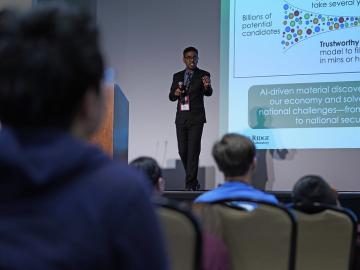
Filter News
Area of Research
- Advanced Manufacturing (1)
- Biology and Environment (41)
- Biology and Soft Matter (1)
- Clean Energy (68)
- Climate and Environmental Systems (2)
- Computational Biology (1)
- Computational Engineering (2)
- Computer Science (4)
- Fusion and Fission (30)
- Fusion Energy (14)
- Isotopes (2)
- Materials (30)
- Materials for Computing (4)
- Mathematics (1)
- National Security (15)
- Neutron Science (11)
- Nuclear Science and Technology (28)
- Nuclear Systems Modeling, Simulation and Validation (2)
- Supercomputing (52)
- Transportation Systems (2)
News Type
News Topics
- (-) Advanced Reactors (22)
- (-) Artificial Intelligence (62)
- (-) Climate Change (76)
- (-) Frontier (26)
- (-) Fusion (42)
- (-) Nuclear Energy (79)
- (-) Security (13)
- (-) Transportation (67)
- 3-D Printing/Advanced Manufacturing (76)
- Big Data (46)
- Bioenergy (68)
- Biology (79)
- Biomedical (41)
- Biotechnology (15)
- Buildings (43)
- Chemical Sciences (37)
- Clean Water (28)
- Composites (18)
- Computer Science (131)
- Coronavirus (29)
- Critical Materials (16)
- Cybersecurity (17)
- Decarbonization (59)
- Education (1)
- Emergency (2)
- Energy Storage (66)
- Environment (153)
- Exascale Computing (27)
- Fossil Energy (5)
- Grid (48)
- High-Performance Computing (55)
- Hydropower (11)
- Irradiation (2)
- Isotopes (33)
- ITER (5)
- Machine Learning (34)
- Materials (79)
- Materials Science (88)
- Mathematics (9)
- Mercury (10)
- Microelectronics (2)
- Microscopy (34)
- Molten Salt (6)
- Nanotechnology (32)
- National Security (45)
- Net Zero (10)
- Neutron Science (77)
- Partnerships (19)
- Physics (38)
- Polymers (20)
- Quantum Computing (25)
- Quantum Science (41)
- Renewable Energy (1)
- Simulation (39)
- Software (1)
- Space Exploration (22)
- Statistics (2)
- Summit (36)
- Sustainable Energy (95)
- Transformational Challenge Reactor (3)
Media Contacts

Two ORNL teams recently completed Cohort 18 of Energy I-Corps, an immersive two-month training program where the scientists define their technology’s value propositions, conduct stakeholder discovery interviews and develop viable market pathways.

Researchers at the Department of Energy’s Oak Ridge National Laboratory and partner institutions have launched a project to develop an innovative suite of tools that will employ machine learning algorithms for more effective cybersecurity analysis of the U.S. power grid.

Oak Ridge National Laboratory has named Troy A. Carter director of the Fusion Energy Division in ORNL’s Fusion and Fission Energy and Science Directorate, or FFESD.

In the wet, muddy places where America’s rivers and lands meet the sea, scientists from the Department of Energy’s Oak Ridge National Laboratory are unearthing clues to better understand how these vital landscapes are evolving under climate change.

SCALE users from 85 organizations across 21 countries gathered online and in person at Oak Ridge National Laboratory from June 5 to June 7 for the Eighth Annual SCALE Users Group Workshop. The meeting included 32 presentations and 14 hands-on tutorials on impactful and innovative applications of SCALE.

Andrew Conant from ORNL's nuclear nonproliferation division is collaborating with national laboratories to analyze isotopes generated in nuclear reactors. This research aims to glean insights into the operations and objectives of these reactors. ORNL, renowned for its leadership in nuclear research, maintains its legacy by promoting the peaceful utilization of nuclear energy worldwide.

A new study conducted on the Frontier supercomputer gave researchers new clues to improving fusion confinement. This research, in collaboration with General Atomics and UC San Diego, uncovered that the interaction between ions and electrons near the tokamak's edge can unexpectedly increase turbulence, challenging previous assumptions about how to optimize plasma confinement for efficient nuclear fusion.

An Oak Ridge National Laboratory team revealed how chemical species form in a highly reactive molten salt mixture of aluminum chloride and potassium chloride by unraveling vibrational signatures and observing ion exchanges.

Researchers at Oak Ridge National Laboratory have developed free data sets to estimate how much energy any building in the contiguous U.S. will use in 2100. These data sets provide planners a way to anticipate future energy needs as the climate changes.

Prasanna Balaprakash, a national leader in artificial intelligence, or AI, spoke to some of the highest achieving students in the country at the National Science Bowl in Washington D.C.


